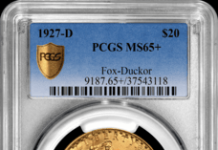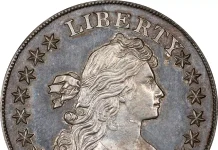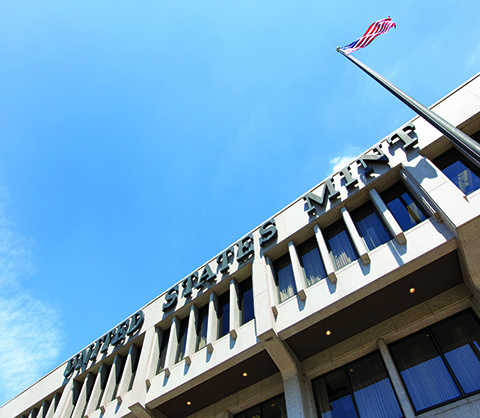
Editor’s Note: This is the second in a two-part series about the history of the first United States Mint, located in Philadelphia. It picks up in 1915 and continues through present day. Enjoy Part I of this series >>>
By David Thomason Alexander
The great Panama-Pacific International Exposition was highlighted by two massive $50 gold coins that attracted more publicity than sales as their face value was a staggering sum for most Americans of that era. After the interruption of the First World War, commemorative coinage resumed in expanding quantities, reaching a dizzying crescendo in 1936 with dozens of subjects, including many trivial subjects of indifferent design.
Open-ended issues struck for years after their nominal commemorative date posed one problem (think Boone, Arkansas, Texas, Oregon Trail among others) as did legislative authorizations that stated “to be struck at the Mints of the US,” clearing the way for Mint mark varieties that were ballyhooed to collectors. After World War II the Booker T. Washington and Carver-Washington half dollars helped kill commemorative coinage for nearly 30 years.
Generating endless interest from 1907 to 1916 was the wave of coin redesign that saw a returning Saint-Gaudens working closely with energetic President Theodore Roosevelt to launch the innovative double eagle (gold $20) with its standing Liberty and flying eagle gold $20 coin against the furious opposition of the aged Barber. The President devoted an amazing number of hours to forcing the new gold piece through over the chief engraver’s stout resistance.
Next came A.A. Weinman’s Indian head and walking eagle $10 piece and Bela Lyon Pratt’s incuse-relief $5 and $2.50 gold coins. Dispute greeted the 1909 Lincoln cent with the prominent initials VDB of designer Victor D. Brenner. A new nickel five cents with Indian head and bison (“buffalo”) was created by James Earle Fraser. Controversy stampeded the Mint into deleting VDB from the cent after production had begun.
As the First World War loomed, the Mint introduced three new silver coin designs, Adolf Alexander Weinman’s Winged Liberty Cap or “Mercury” dime; his stately Walking Liberty half dollar; and Hermon McNeil’s Standing Liberty quarter. In 1932 a Washington bust by John Flanagan replaced Standing Liberty; a Jefferson bust and view of Monticello by Felix Schlag superseded the beloved buffalo on the nickel in 1938.

ultra-high relief on $20 gold coins issued in 2009. (Photo courtesy the United States Mint)
The first world war had seen coinage totals reach astonishing heights, but after the armistice a devastating economic recession caused dramatic reduction in coinage production in Philadelphia and Denver. The Great Depression that began in 1929 led to its own stresses in coinage as in all other fields in a prostrate nation.
World War II posed even greater challenges to the Philadelphia Mint, now ably directed by Nellie Tayloe Ross, former governor of Wyoming and prominent figure in President Franklin Delano Roosevelt’s New Deal. The commemorative coin boom peaked and crashed during her directorship; the onset of World War II brought critical shortages of copper and nickel that were overcome by creation of zinc-steel Lincoln cents and silver-manganese nickels.
Around-the-clock production became the rule during the war as production of military medals skyrocketed. Getting back to normal after 1945 proved difficult as “the new normal” was vastly different from the prewar years. A new Franklin D. Roosevelt dime was created after FDR’s death by Mint Engraver John Roy Sinnock (1888-1947). For unknown reasons the Walking Liberty half dollar yielded to a new Benjamin Franklin-Liberty Bell design by the same engraver.
A career work in the Philadelphia Mint brought job security but little scope for art or creativity. A man (there were no woman engravers) like Sinnock could join the staff in 1917 and remain until his death in 1947. Coin design changes were few and far between, though some medal design work was offered including new portrait pieces of Presidents, Secretaries of the Treasury and Mint Directors.
Ms. Ross left office in 1953 and was succeeded by William Howard Brett, last of the traditional directors, who showed a surly face to the world, especially to coin collectors. The first numismatic tabloid newspapers appeared during his term of office, Numismatic News in 1952; Coin World in 1960. Brett scorned both, offering one inconsequential interview to Coin World Editor Margo Russell.
Nevada native Eva Adams was appointed Mint Director (1961-1969) by President John F. Kennedy. The politically astute Adams had served as administrative assistant to Senators Pat McCarran and Alan Bible and had remarkable knowledge of the capital political scene. As director, Adams received endless adulation of Coin World Editor Russell, who filled the weekly with every kind of Adams report to make the director a media star.
The readership begged to differ, remembering Adams’ threat to jail coin collectors for supposedly causing the national coin shortage, halting Proof coin production and finally eliminating Mint marks and freezing dates to discourage collectors further. Dispassionate observers pointed to the vast expansion of coin-operated machines with their warehousing millions of coins as the real cause of the shortage.
Calls for a resumption of commemorative coinage persisted during Adams’ term, and under her successor Mary Brooks. The Mint’s frozen, repetitive list cited encouragement of counterfeiting and confusion of the public. The Centennial of the Civil War was marked only by official medals portraying Generals Ulysses S. Grant and Robert E. Lee by sculptor Joseph Renier.
The 1963 assassination of President John F. Kennedy brought the rapid-fire creation of a
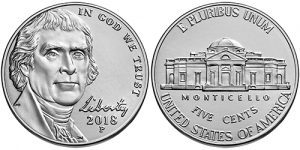
quasi-commemorative half dollar bearing his portrait by Chief Engraver Gilroy Roberts and the American eagle by his assistant Frank Gasparro. Dated 1964, this coin was the last struck in .900 silver. The public snapped up the new coins and hoarded them, and the half dollar denomination faded from public view.
The value of silver was now surging and countries near and far were abandoning the metal for circulating coinage. Most went for an alloy of 75 copper and 25 nickel; Canada opted for pure nickel. The US Mint gave profound attention to the needs of the vending machine industry and came up with a complex formulation of 75-25 copper-nickel “cladding” over a pure copper core.
The new “red edge” coins were struck by the millions, as the Treasury and Mint convinced themselves that the billions of .900 silver coins already in circulation would remain there, side by side with the new clad coins. The half dollar was struck in a .400 fine silver clad alloy, but these too were hoarded and this denomination vanished from circulation. Gasparro’s new clad dollar appeared portraying former President Dwight D. Eisenhower, but only saw the most limited circulation.
Construction of a new Philadelphia Mega-Mint between 1965-1969 finally eliminated cobwebs of the supposed shortage and Adams left office in August 1969 and became a senior stateswoman of the numismatic world, succeeded by fellow-westerner Mary Brooks of Idaho.
During her term, the roster of Mint products began their explosive modern growth and numismatists of the future may well shake their heads at this incredible expansion of collectibles that overcame longstanding and seemingly permanent barriers, including the Mint’s traditional rejection of commemorative coins and of gold.
The Bicentennial of the American Revolution was greeted by redesigned dollars, half dollars and quarters with new reverses and dual dates 1776-1976 that were struck in both clad and silver clad material. These were not specifically called commemoratives, but under Brooks’ successors Stella Hackel and Philip N. Diehl more and more dramatic changes were rapidly introduced.
During 1978 plans were introduced for new 26.5mm circulating dollar coins. Former Chief Engraver Gilroy Roberts had ended his US Mint career to join the staff of the explosively-growing Franklin Mint, headed by entrepreneur Joseph Segel. Following him in Philadelphia was career Mint engraver Frank Gasparro, who planned a return of the Liberty head with cap on pole of the 1790’s copper cents with a new flying eagle reverse.
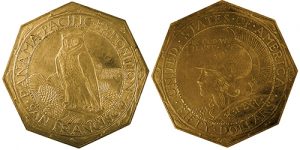
Special interests now arrived in force and the outcry for a female portrait proved irresistible. Liberty was shoved aside in favor of a portrait of women’s rights advocate Susan B. Anthony. Gasparro joined a portrait with severe features to a reverse adapted from his earlier Eisenhower dollar.
With a diameter almost that of the quarter, the SBA dollar utterly confused the public and faced near-total rejection. In 2000, Glenna Goodacre’s Sacagawea dollar appeared in the same ill-fated diameter in a gold-colored alloy of copper-nickel-zinc-manganese. Despite heroic efforts by the Treasury, this new dollar also failed to win public acceptance.
Later non-circulating dates bore reverses honoring Native American contributions to US history. In 2007, another circulating dollar effort got underway with the presidential series beginning with George Washington. The public also proved indifferent to these innovative portrait coins.
Vastly more successful were the Statehood quarters of 1999-2008 that circulated widely and were also issued as .900 fine silver Proofs offered at reasonable costs. Following a similar course were the America the Beautiful quarters scheduled for 2010-2021. One criticism of these circulating commemoratives was that their relatively small diameters obscure the beauty of the designs.
Overcoming this objection is the 3-inch .999 silver, five-ounce series launched in 2010. Not intended to circulate, this series represents another startling expansion into the realm of bullion coinage. If the Mint’s turnabout on commemoratives in 1982 was dramatic, this excursion into bullion is vastly more so.
The Mint’s first effort faced a granite wall of opposition to gold erected during the New Deal of the 1930’s when the precious metal was derided as a “barbarous relic” of earlier times. This bullion effort was named the American Arts Gold Medallion series of 1980-1985, mandated by Congress to supply American citizens with an alternative to the South African krugerrand, Canadian maple leaf and other widely traded bullion pieces.
The American Arts series was not a success, but Miley Busiek’s 1986 reworking of the Saint-Gaudens $20 into the one-ounce $50 bullion coin and the addition of three fractional pieces was an unqualified victory for bullion. It was soon joined by the .999 silver eagle, denominated as a dollar.
Subsequent issues include the 2008-2013 .999 gold American Buffalo, a recreation of James Earle Fraser’s buffalo nickel in larger format. Also struck in .999 gold as $10 pieces are the First Spouse coins portraying wives of the Presidents since Washington, with Liberty heads filling in for Presidencies of widowed or single chief executives. Then came the MMIX (2009) ultra-high relief $20 coin showing the 1907 Augustus Saint-Gaudens’ design in reduced diameter and truly extraordinary relief.
Most of these new bullion pieces and all of the platinum issues that began in 1997 are beyond the reach of collectors of average means. As fascinating as they are, few will ever grace the collections of ordinary citizens.
This silent video offers a glimpse at the Philadelphia Mint today. Enjoy….
Almost as dramatic as the bullion bloom was the unexpected return of commemorative coins in 1982 with the silver half dollar honoring the 250th anniversary of George Washington’s birth. This coin represented a short-lived foray into the world of fine arts under Chief Engraver Elizabeth Jones, a sculptor of international reputation, all too soon sandbagged by jealous higher-ups and disloyal underlings.
The floodgates opened in 1982 to a flood of silver, gold and clad commemoratives that put all 1892-1954 issues in the shade. Subjects and designs proliferated, prices rose ever higher amid spirited controversy that had little effect on ongoing issues. Some designs like Elizabeth Jones’ gold 1988 W Olympic five dollars received wide acclaim. Others, most notably the 1988 Korean War 38th anniversary silver dollar, drew considerable ridicule.
Whole books could be written about these “second series” US commemoratives which have continued to the present. It will be curious to see how these coins perform over coming decades and compare their market performance to that of classic commemoratives of 1892-1954.
Considered together, all of these fascinating coins make up the tapestry of the Philadelphia Mint from 1793 down to the present day. Any and all will reward future collectors’ interest as they have nourished collectors of the past.

